A general model of fractional frequency reuse: Modelling and performance analysis
Fractional Frequency Reuse (FFR) is a promising to improve the spectrum e ciency in
the LongTerm Evolution (LTE) cellular network. In the literature, various research works have
been conducted to evaluate the performance of FFR. However, the presented analytical approach
only dealt with the special cases in which the users are divided into 2 groups and only two power
levels are utilised. In this paper, we consider a general case of FFR in which the users are
classified into groups and each group is assigned a serving power level. The mathematical model
of the general FFR is presented and analysed through a stochastic geometry approach. The derived
analytical results in terms of average coverage probability can covered all the related well-known
results in the literature.
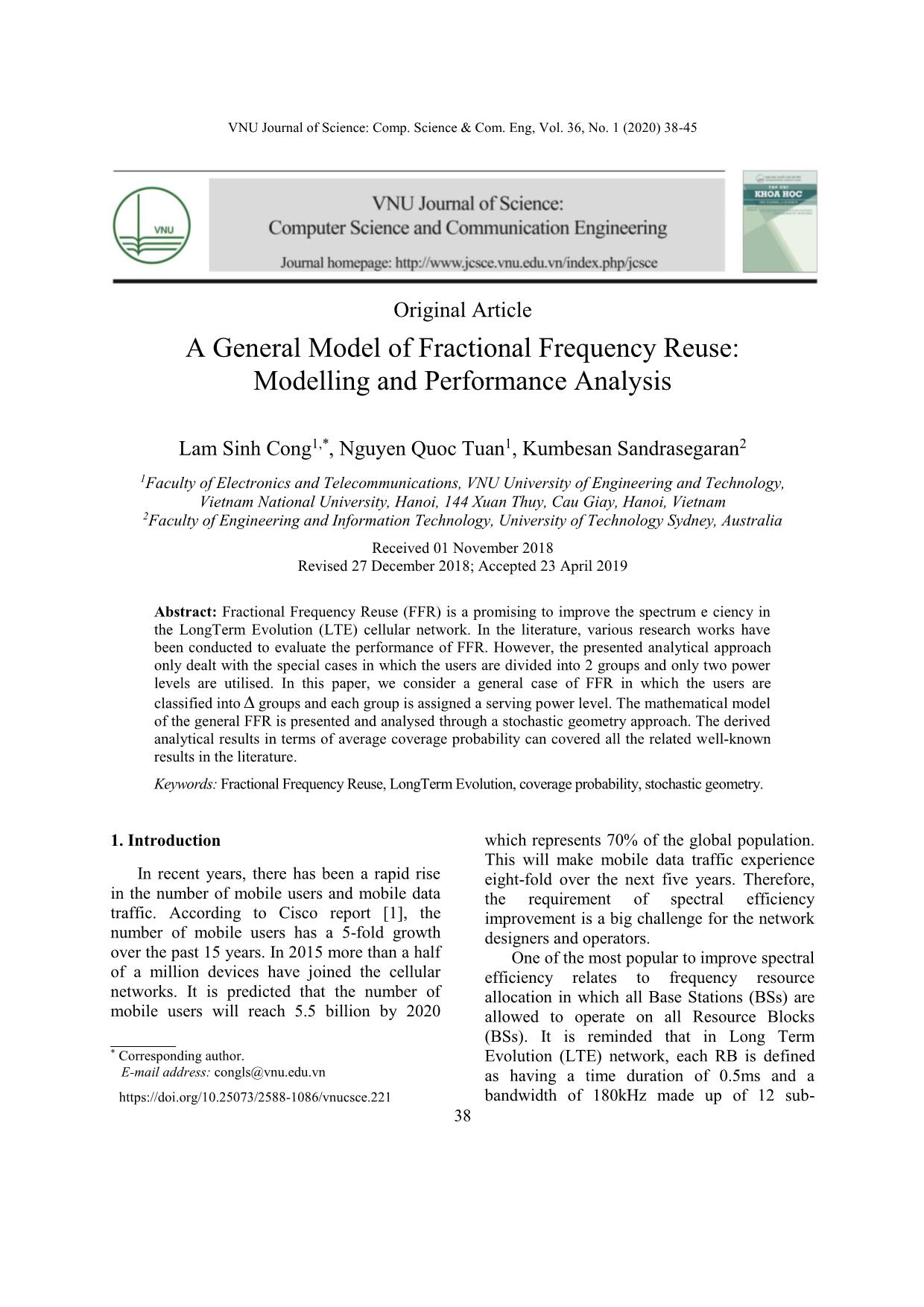
Trang 1
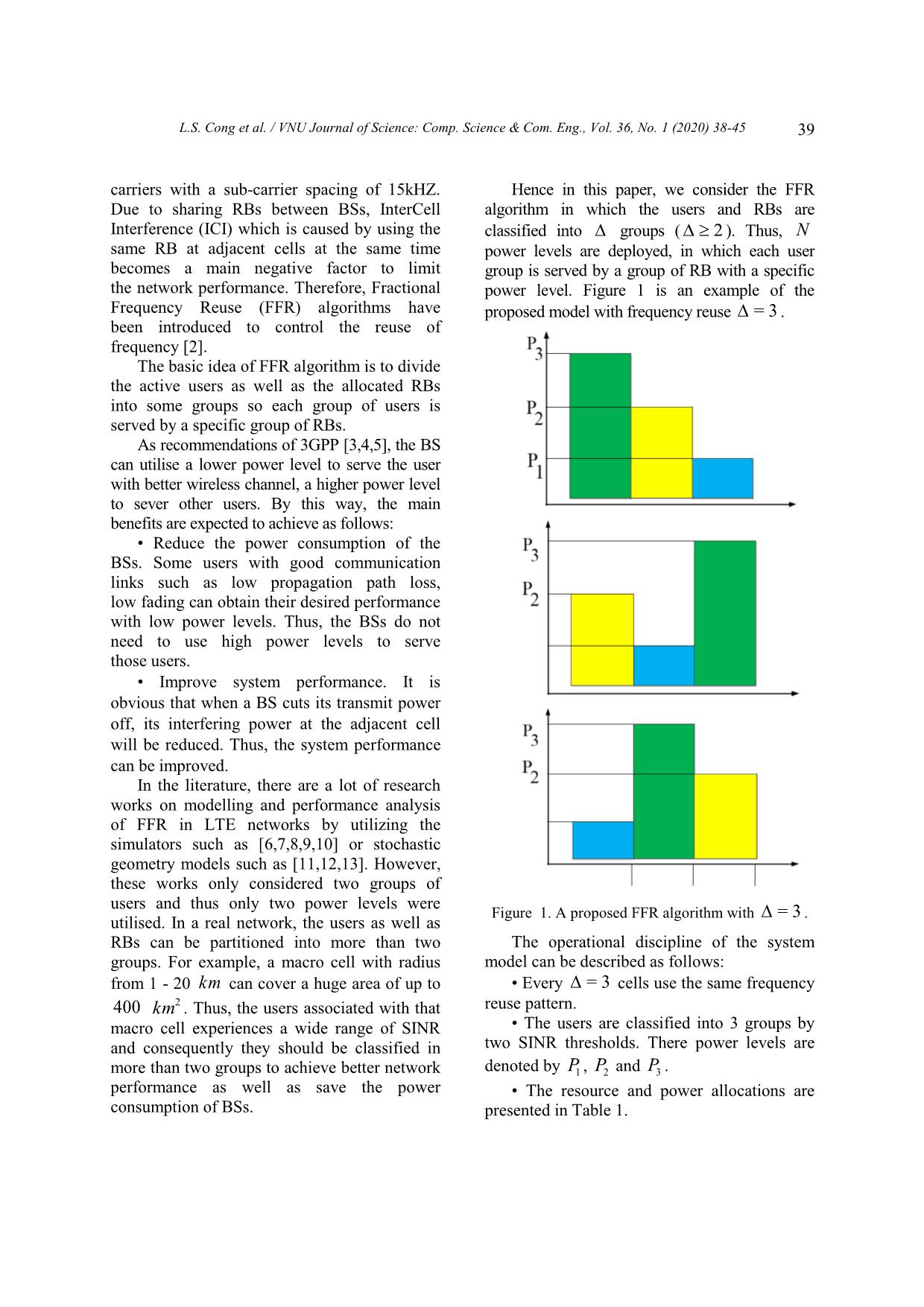
Trang 2
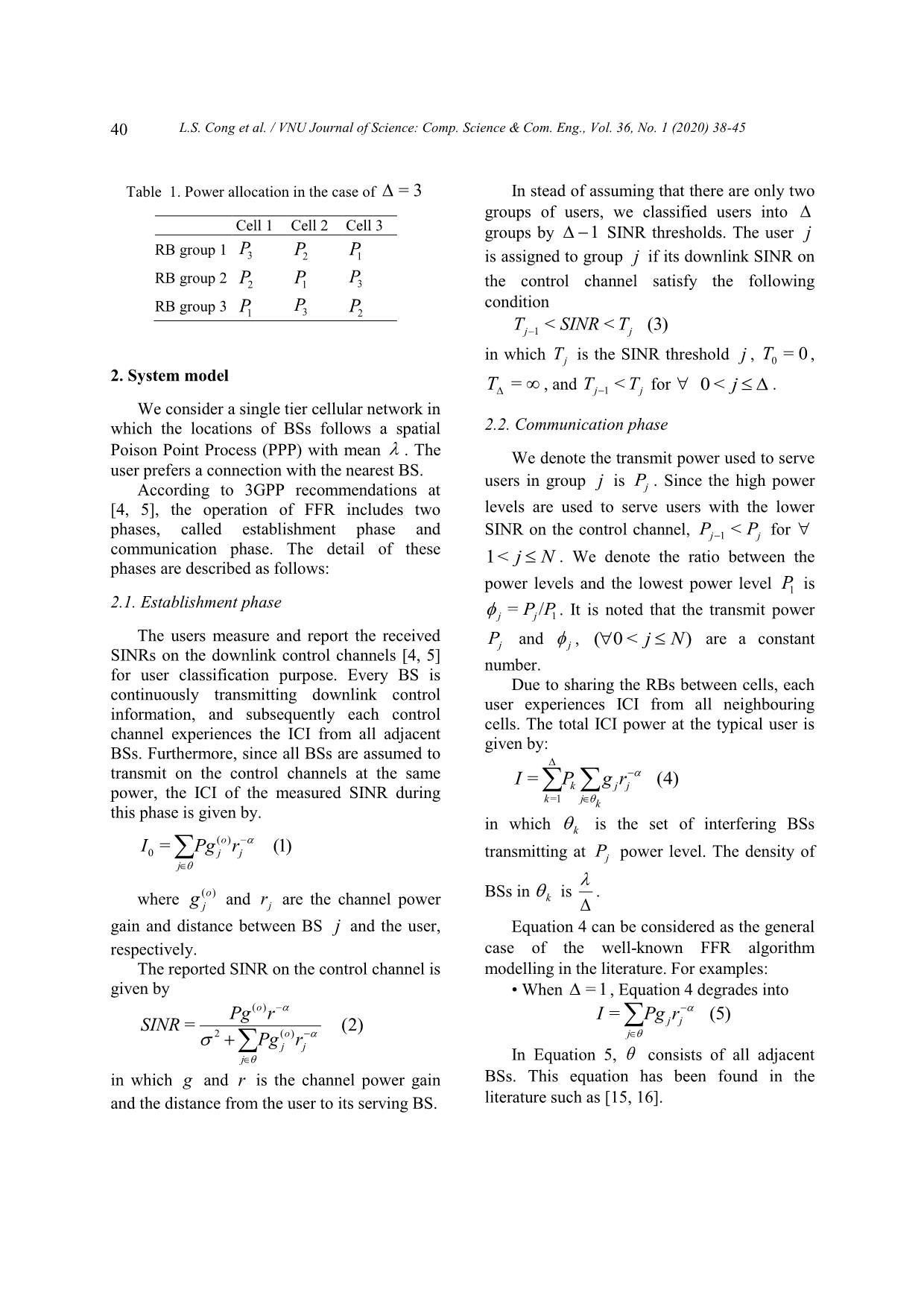
Trang 3
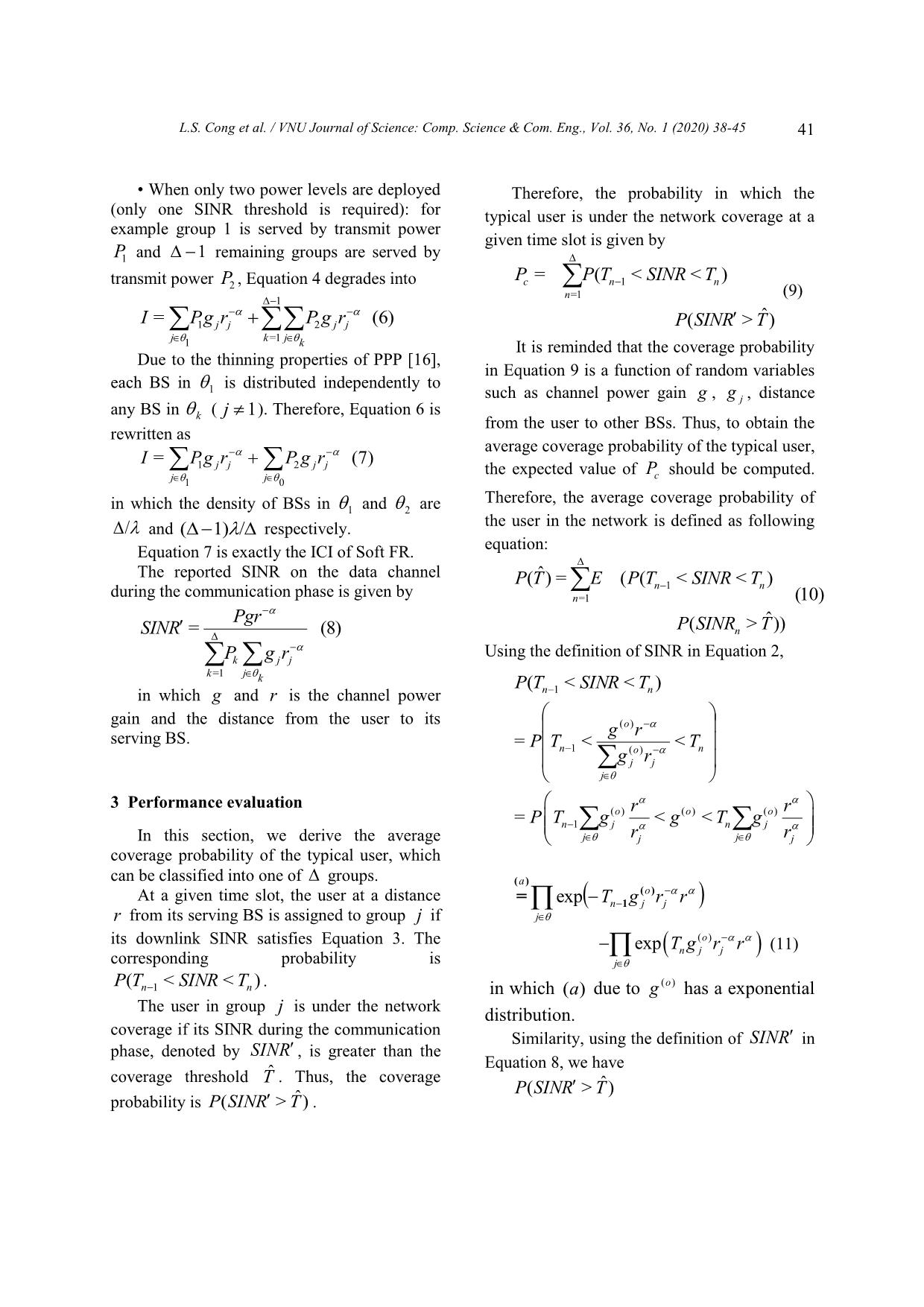
Trang 4
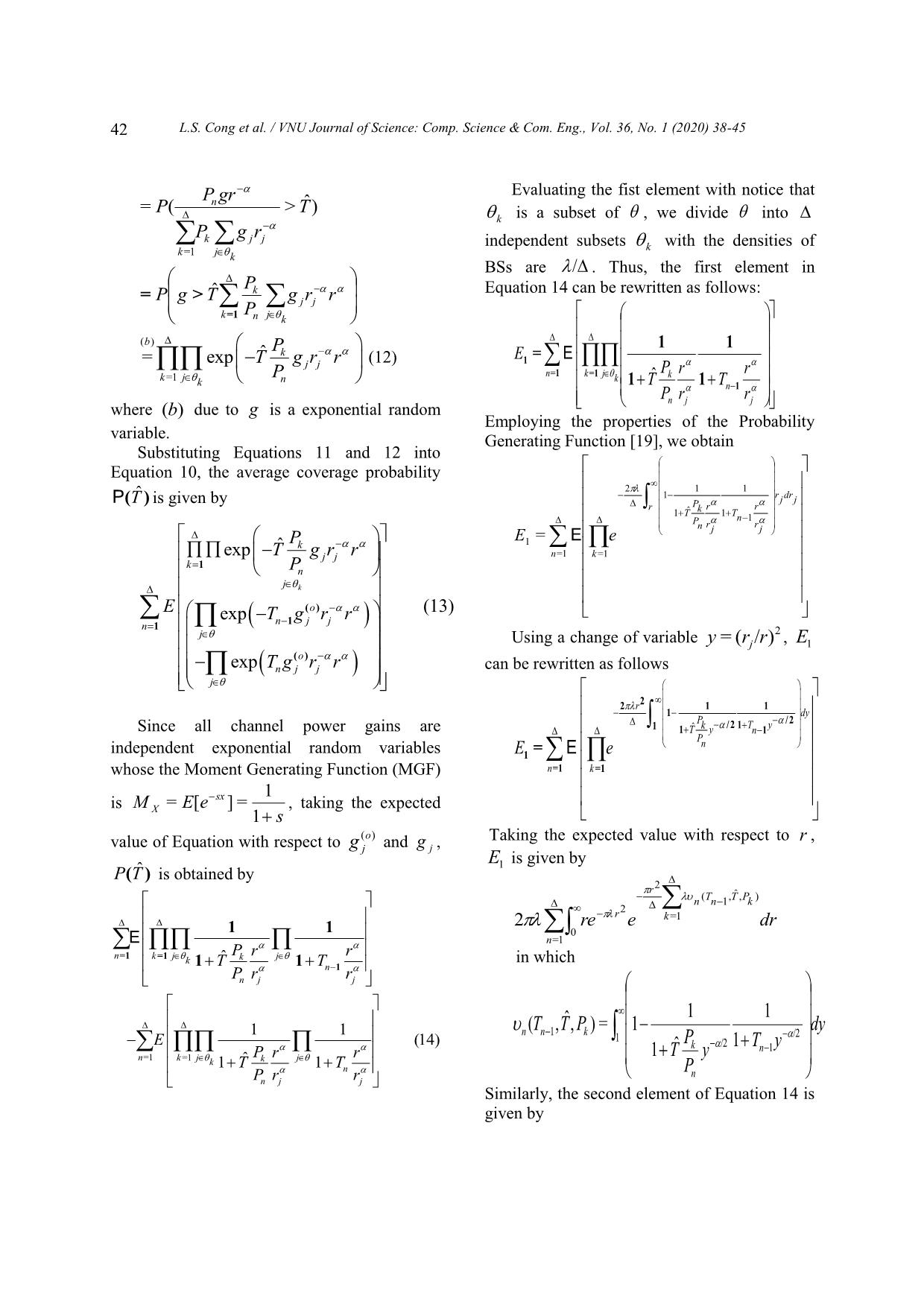
Trang 5
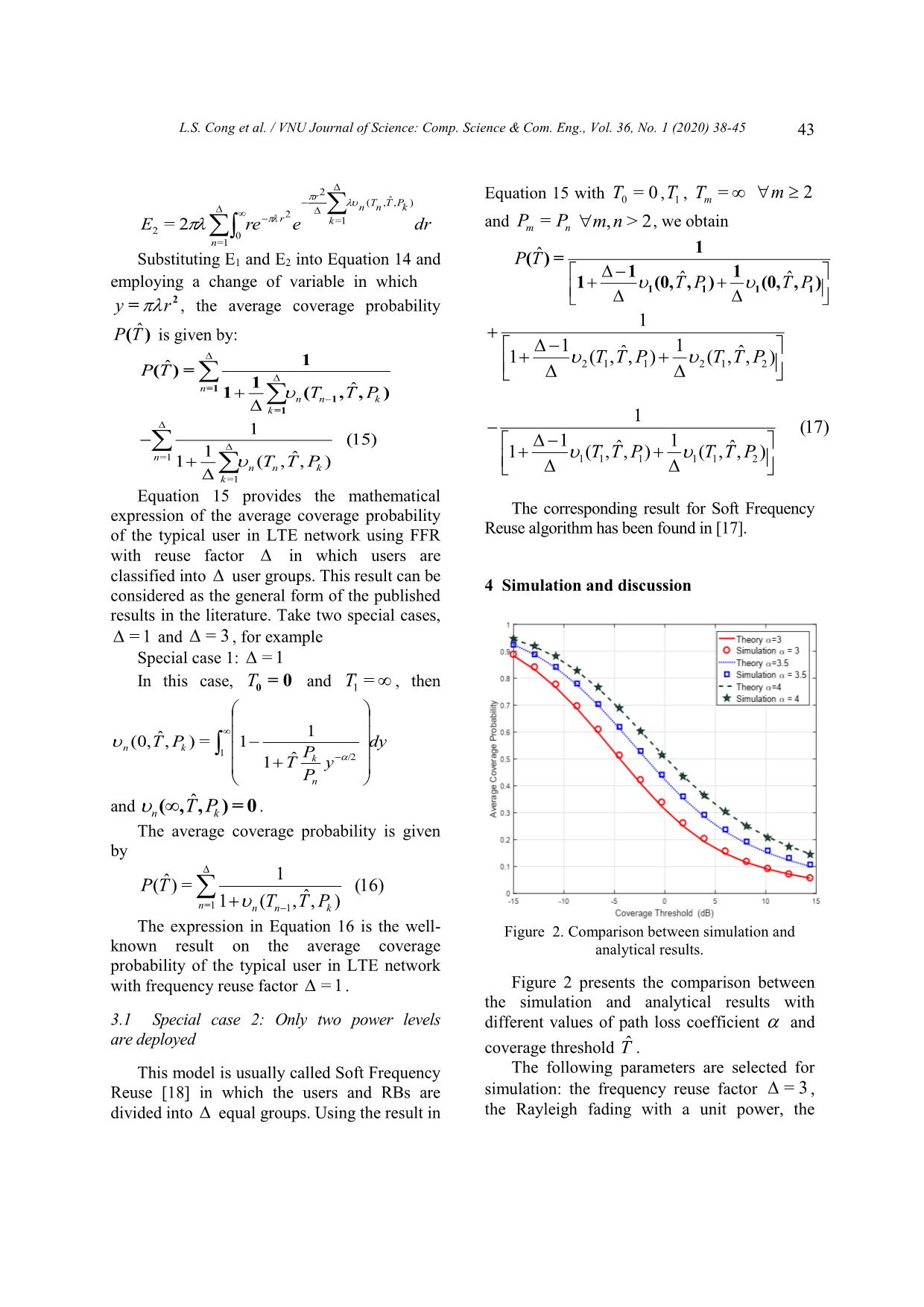
Trang 6
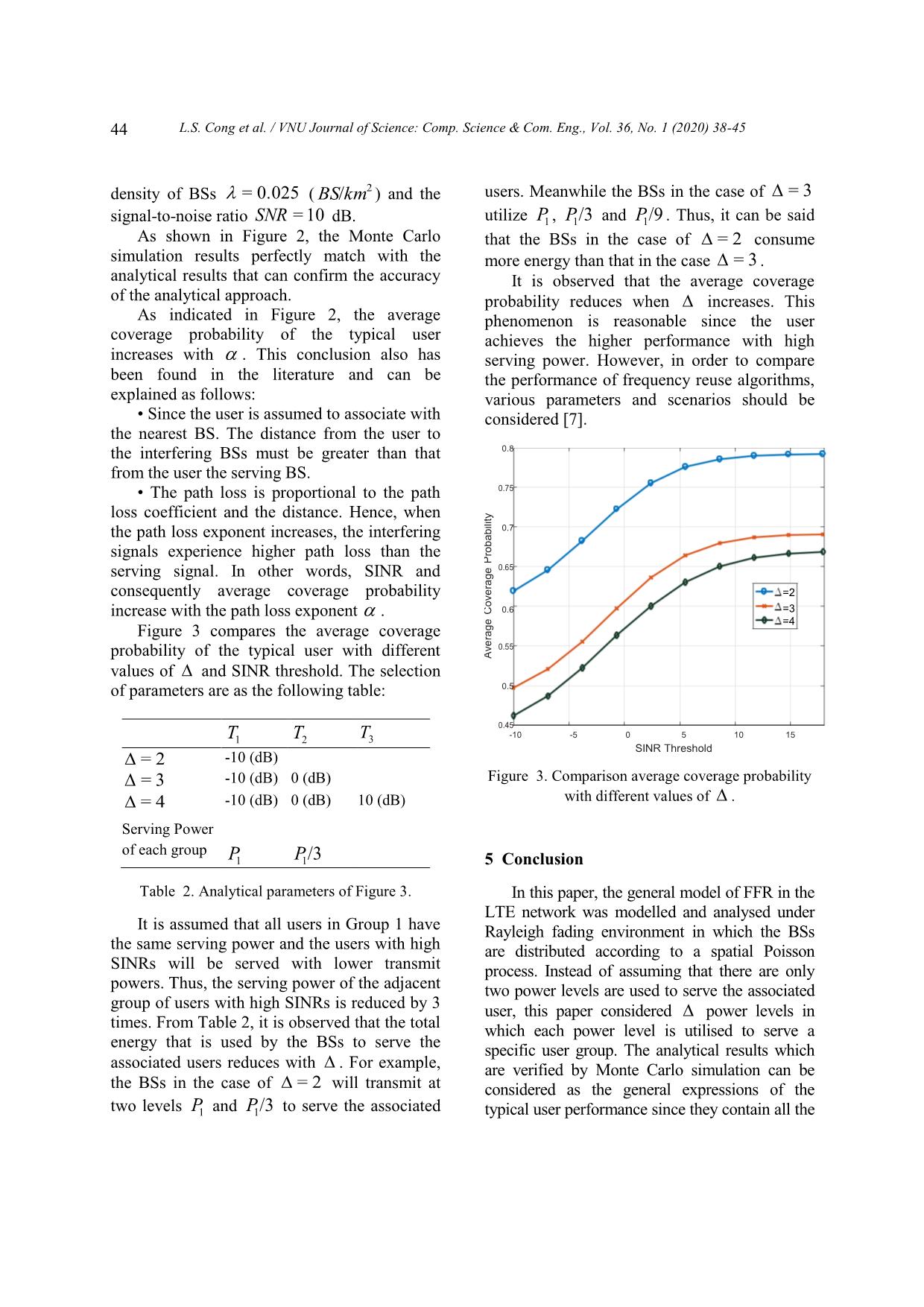
Trang 7
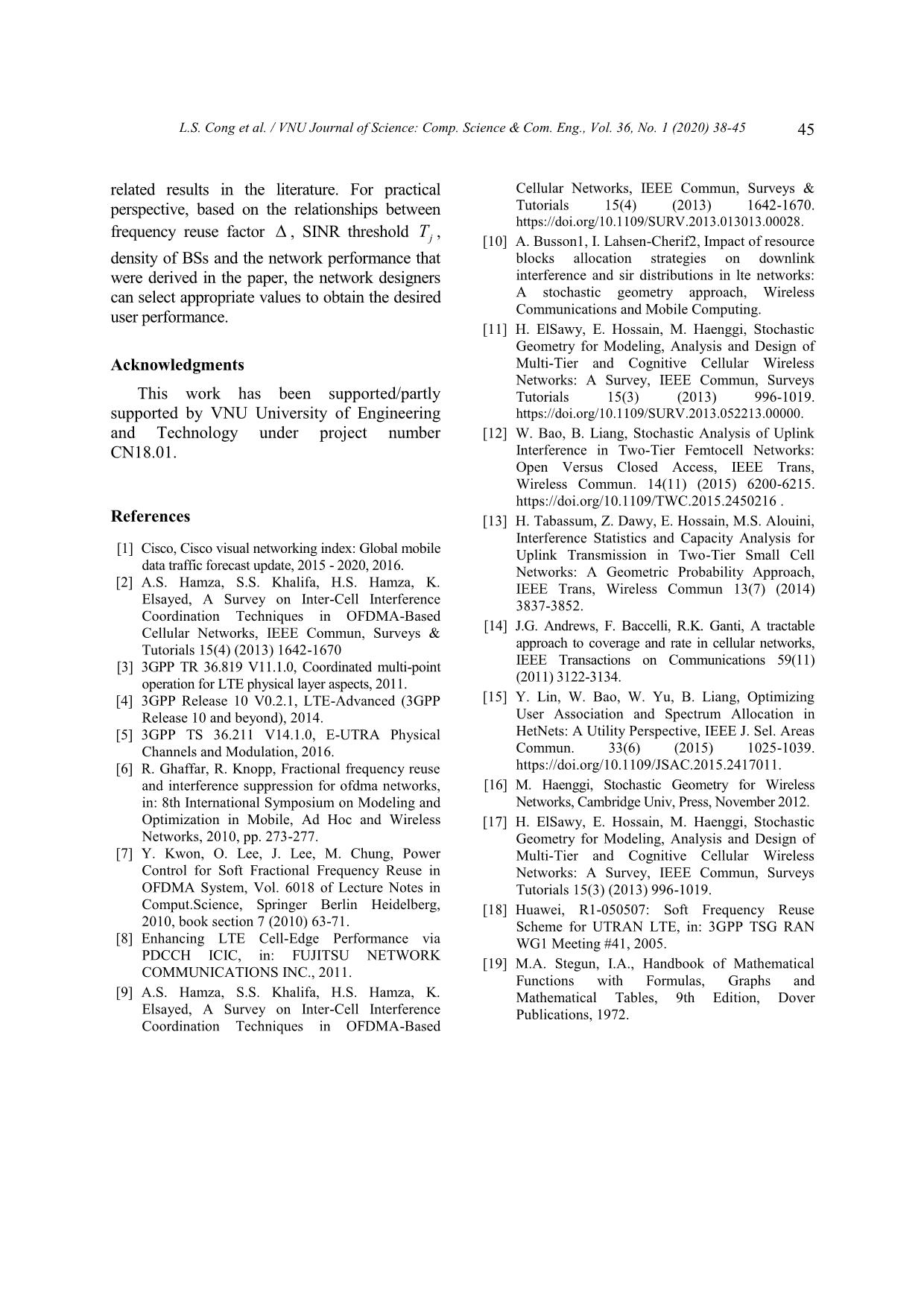
Trang 8
Tóm tắt nội dung tài liệu: A general model of fractional frequency reuse: Modelling and performance analysis
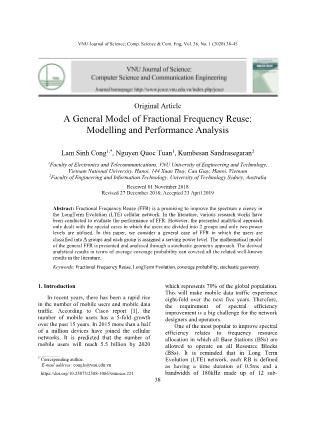
trol channels [4, 5] number. for user classification purpose. Every BS is Due to sharing the RBs between cells, each continuously transmitting downlink control user experiences ICI from all neighbouring information, and subsequently each control cells. The total ICI power at the typical user is channel experiences the ICI from all adjacent given by: BSs. Furthermore, since all BSs are assumed to transmit on the control channels at the same IPgr=(4) power, the ICI of the measured SINR during kjj kj=1 k this phase is given by. in which k is the set of interfering BSs IPgr=(1) ()o 0 jj transmitting at Pj power level. The density of j (o) BSs in k is . where g j and rj are the channel power gain and distance between BS j and the user, Equation 4 can be considered as the general respectively. case of the well-known FFR algorithm The reported SINR on the control channel is modelling in the literature. For examples: given by • When = 1, Equation 4 degrades into ()o Pg r I= Pgjj r (5) SINR =2 (o ) (2) j Pgjj r j In Equation 5, consists of all adjacent in which g and r is the channel power gain BSs. This equation has been found in the and the distance from the user to its serving BS. literature such as [15, 16]. L.S. Cong et al. / VNU Journal of Science: Comp. Science & Com. Eng., Vol. 36, No. 1 (2020) 38-45 41 • When only two power levels are deployed Therefore, the probability in which the (only one SINR threshold is required): for typical user is under the network coverage at a example group 1 is served by transmit power given time slot is given by P1 and 1 remaining groups are served by PPTSINRT=(<<) transmit power P2 , Equation 4 degrades into cnn 1 n=1 (9) 1 ˆ IPgrP=(6) gr12jjjj PSINRT(>) jkj =1 1 k It is reminded that the coverage probability Due to the thinning properties of PPP [16], in Equation 9 is a function of random variables each BS in 1 is distributed independently to such as channel power gain g , g j , distance any BS in ( j 1). Therefore, Equation 6 is k from the user to other BSs. Thus, to obtain the rewritten as average coverage probability of the typical user, IPgrP=(7) gr12jjjj the expected value of Pc should be computed. jj 10 Therefore, the average coverage probability of in which the density of BSs in 1 and 2 are / and ( 1)/ respectively. the user in the network is defined as following Equation 7 is exactly the ICI of Soft FR. equation: The reported SINR on the data channel ˆ P() TEP =((<<) TSINRT nn 1 during the communication phase is given by n=1 (10) Pgr ˆ P(>)) SINRTn SINR =(8) Using the definition of SINR in Equation 2, Pgkjj r kj=1 k P(T < SINR < T ) in which g and r is the channel power n 1 n gain and the distance from the user to its (o) serving BS. g r = P Tn 1 < (o) < Tn g j rj j 3 Performance evaluation rr =<<P TggTg (ooo )( )( ) njnj 1 In this section, we derive the average jj rrjj coverage probability of the typical user, which can be classified into one of groups. (a) At a given time slot, the user at a distance (o) = exp Tn 1g j rj r r from its serving BS is assigned to group j if j its downlink SINR satisfies Equation 3. The ()o exp Tnjj grr (11) corresponding probability is j P(T < SINR < T ) . (o) n 1 n in which (a) due to g has a exponential The user in group j is under the network distribution. coverage if its SINR during the communication Similarity, using the definition of SINR in phase, denoted by SINR , is greater than the Equation 8, we have coverage threshold Tˆ . Thus, the coverage P(SINR > Tˆ) probability is P(SINR > Tˆ) . 42 L.S. Cong et al. / VNU Journal of Science: Comp. Science & Com. Eng., Vol. 36, No. 1 (2020) 38-45 P gr Evaluating the fist element with notice that = P( n > Tˆ) k is a subset of , we divide into Pk g jrj independent subsets k with the densities of k=1 j k BSs are / . Thus, the first element in ˆ Pk Equation 14 can be rewritten as follows: = P g > T g j rj r k=1 P j n k ()b 1 1 Pk =exp Tgrrˆ (12) E1 = E jj P r r kj=1 P n=1 k=1 j ˆ k k n k 1 T 1 T n 1 Pn rj rj where (b) due to g is a exponential random Employing the properties of the Probability variable. Generating Function [19], we obtain Substituting Equations 11 and 12 into Equation 10, the average coverage probability 2 1 1 ˆ 1 r dr P(T ) is given by P j j r ˆ k r r 1 T 1 Tn 1 P n rj rj P E1 = E e ˆ k exp Tg rr jj n=1 k =1 k 1 Pn j k E ()o (13) exp Tgrrnjj 1 n 1 2 j Using a change of variable y = (r /r) , E j 1 ()o exp Tnjj grr can be rewritten as follows j 2 r2 1 1 1 dy Pk /2 1 Ty /2 Since all channel power gains are 1 1 Tyˆ n 1 P independent exponential random variables n Ee1 = E whose the Moment Generating Function (MGF) n=1 k =1 1 is M = E[e sx ] = , taking the expected X 1 s (o) Taking the expected value with respect to r , value of Equation with respect to g j and g j , E is given by ˆ 1 PT() is obtained by r2 (T ,Tˆ,P ) n n 1 k 2 r k=1 2 re e dr 11 0 E n=1 n=1 P rr k=1 j k ˆ k j in which 11 TT n 1 P r r n j j 1 1 ˆ 11 n (Tn 1,T, Pk ) = 1 /2 dy E (14) 1 P /2 1 T y P rr 1 Tˆ k y n 1 n=1 k=1 jj k 11 TTˆ k n Pn Pn rr jj Similarly, the second element of Equation 14 is given by L.S. Cong et al. / VNU Journal of Science: Comp. Science & Com. Eng., Vol. 36, No. 1 (2020) 38-45 43 r2 Equation 15 with T = 0 ,T , T = m 2 (T ,Tˆ,P ) 0 1 m n n k 2 r k=1 and P = P , we obtain E2 = 2 re e dr m n m,n > 2 0 n=1 1 Substituting E and E into Equation 14 and PT()ˆ = 1 2 11 employing a change of variable in which ˆˆ 1(0,,)(0,,) 1111 TPTP 2 yr= , the average coverage probability 1 PT()ˆ is given by: 1 1 1 1 (T ,Tˆ, P ) (T ,Tˆ, P ) PT()ˆ = 2 1 1 2 1 2 1 n=1 1(,,) TTP ˆ nnk 1 k=1 1 1 (17) (15) 11 1 1 (TTPTTP ,ˆˆ , ) ( , , ) n=1 1(,,) TTPˆ 1 1 1 1 1 2 nnk k=1 Equation 15 provides the mathematical expression of the average coverage probability The corresponding result for Soft Frequency of the typical user in LTE network using FFR Reuse algorithm has been found in [17]. with reuse factor in which users are classified into user groups. This result can be 4 Simulation and discussion considered as the general form of the published results in the literature. Take two special cases, = 1 and = 3 , for example Special case 1: = 1 In this case, T0 =0 and T1 = , then ˆ 1 n (0,T, Pk ) = 1 dy 1 P 1 Tˆ k y /2 P n ˆ and nk( ,TP , ) = 0 . The average coverage probability is given by 1 PT()ˆ =(16) n=1 1(,,) TTP ˆ nnk 1 The expression in Equation 16 is the well- Figure 2. Comparison between simulation and known result on the average coverage analytical results. probability of the typical user in LTE network with frequency reuse factor = 1. Figure 2 presents the comparison between the simulation and analytical results with 3.1 Special case 2: Only two power levels different values of path loss coefficient and are deployed coverage threshold Tˆ . This model is usually called Soft Frequency The following parameters are selected for Reuse [18] in which the users and RBs are simulation: the frequency reuse factor = 3 , divided into equal groups. Using the result in the Rayleigh fading with a unit power, the 44 L.S. Cong et al. / VNU Journal of Science: Comp. Science & Com. Eng., Vol. 36, No. 1 (2020) 38-45 density of BSs = 0.025 ( BS/km2 ) and the users. Meanwhile the BSs in the case of = 3 signal-to-noise ratio SN R = 10 dB. utilize P1 , P1/3 and P1/9 . Thus, it can be said As shown in Figure 2, the Monte Carlo that the BSs in the case of = 2 consume simulation results perfectly match with the more energy than that in the case = 3 . analytical results that can confirm the accuracy It is observed that the average coverage of the analytical approach. probability reduces when increases. This As indicated in Figure 2, the average phenomenon is reasonable since the user coverage probability of the typical user achieves the higher performance with high increases with . This conclusion also has serving power. However, in order to compare been found in the literature and can be the performance of frequency reuse algorithms, explained as follows: various parameters and scenarios should be • Since the user is assumed to associate with considered [7]. the nearest BS. The distance from the user to the interfering BSs must be greater than that 0.8 from the user the serving BS. • The path loss is proportional to the path 0.75 loss coefficient and the distance. Hence, when the path loss exponent increases, the interfering 0.7 signals experience higher path loss than the Probability serving signal. In other words, SINR and 0.65 age consequently average coverage probability =2 0.6 =3 Cover increase with the path loss exponent . =4 Figure 3 compares the average coverage 0.55 probability of the typical user with different Average values of and SINR threshold. The selection of parameters are as the following table: 0.5 0.45 T1 T2 T3 -10 -5 0 5 10 15 SINR Threshold = 2 -10 (dB) = 3 -10 (dB) 0 (dB) Figure 3. Comparison average coverage probability = 4 -10 (dB) 0 (dB) 10 (dB) with different values of . Serving Power of each group P1 P1/3 5 Conclusion Table 2. Analytical parameters of Figure 3. In this paper, the general model of FFR in the LTE network was modelled and analysed under It is assumed that all users in Group 1 have Rayleigh fading environment in which the BSs the same serving power and the users with high are distributed according to a spatial Poisson SINRs will be served with lower transmit process. Instead of assuming that there are only powers. Thus, the serving power of the adjacent two power levels are used to serve the associated group of users with high SINRs is reduced by 3 user, this paper considered power levels in times. From Table 2, it is observed that the total which each power level is utilised to serve a energy that is used by the BSs to serve the specific user group. The analytical results which associated users reduces with . For example, are verified by Monte Carlo simulation can be the BSs in the case of = 2 will transmit at considered as the general expressions of the two levels P1 and P1/3 to serve the associated typical user performance since they contain all the L.S. Cong et al. / VNU Journal of Science: Comp. Science & Com. Eng., Vol. 36, No. 1 (2020) 38-45 45 related results in the literature. For practical Cellular Networks, IEEE Commun, Surveys & perspective, based on the relationships between Tutorials 15(4) (2013) 1642-1670. https://doi.org/10.1109/SURV.2013.013013.00028. frequency reuse factor , SINR threshold T , j [10] A. Busson1, I. Lahsen-Cherif2, Impact of resource density of BSs and the network performance that blocks allocation strategies on downlink were derived in the paper, the network designers interference and sir distributions in lte networks: can select appropriate values to obtain the desired A stochastic geometry approach, Wireless user performance. Communications and Mobile Computing. [11] H. ElSawy, E. Hossain, M. Haenggi, Stochastic Geometry for Modeling, Analysis and Design of Acknowledgments Multi-Tier and Cognitive Cellular Wireless Networks: A Survey, IEEE Commun, Surveys This work has been supported/partly Tutorials 15(3) (2013) 996-1019. supported by VNU University of Engineering https://doi.org/10.1109/SURV.2013.052213.00000. and Technology under project number [12] W. Bao, B. Liang, Stochastic Analysis of Uplink CN18.01. Interference in Two-Tier Femtocell Networks: Open Versus Closed Access, IEEE Trans, Wireless Commun. 14(11) (2015) 6200-6215. https://doi.org/10.1109/TWC.2015.2450216 . References [13] H. Tabassum, Z. Dawy, E. Hossain, M.S. Alouini, Interference Statistics and Capacity Analysis for [1] Cisco, Cisco visual networking index: Global mobile Uplink Transmission in Two-Tier Small Cell data traffic forecast update, 2015 - 2020, 2016. Networks: A Geometric Probability Approach, [2] A.S. Hamza, S.S. Khalifa, H.S. Hamza, K. IEEE Trans, Wireless Commun 13(7) (2014) Elsayed, A Survey on Inter-Cell Interference 3837-3852. Coordination Techniques in OFDMA-Based Cellular Networks, IEEE Commun, Surveys & [14] J.G. Andrews, F. Baccelli, R.K. Ganti, A tractable Tutorials 15(4) (2013) 1642-1670 approach to coverage and rate in cellular networks, [3] 3GPP TR 36.819 V11.1.0, Coordinated multi-point IEEE Transactions on Communications 59(11) operation for LTE physical layer aspects, 2011. (2011) 3122-3134. [4] 3GPP Release 10 V0.2.1, LTE-Advanced (3GPP [15] Y. Lin, W. Bao, W. Yu, B. Liang, Optimizing Release 10 and beyond), 2014. User Association and Spectrum Allocation in [5] 3GPP TS 36.211 V14.1.0, E-UTRA Physical HetNets: A Utility Perspective, IEEE J. Sel. Areas Channels and Modulation, 2016. Commun. 33(6) (2015) 1025-1039. [6] R. Ghaffar, R. Knopp, Fractional frequency reuse https://doi.org/10.1109/JSAC.2015.2417011. and interference suppression for ofdma networks, [16] M. Haenggi, Stochastic Geometry for Wireless in: 8th International Symposium on Modeling and Networks, Cambridge Univ, Press, November 2012. Optimization in Mobile, Ad Hoc and Wireless [17] H. ElSawy, E. Hossain, M. Haenggi, Stochastic Networks, 2010, pp. 273-277. Geometry for Modeling, Analysis and Design of [7] Y. Kwon, O. Lee, J. Lee, M. Chung, Power Multi-Tier and Cognitive Cellular Wireless Control for Soft Fractional Frequency Reuse in Networks: A Survey, IEEE Commun, Surveys OFDMA System, Vol. 6018 of Lecture Notes in Tutorials 15(3) (2013) 996-1019. Comput.Science, Springer Berlin Heidelberg, [18] Huawei, R1-050507: Soft Frequency Reuse 2010, book section 7 (2010) 63-71. Scheme for UTRAN LTE, in: 3GPP TSG RAN [8] Enhancing LTE Cell-Edge Performance via WG1 Meeting #41, 2005. PDCCH ICIC, in: FUJITSU NETWORK [19] M.A. Stegun, I.A., Handbook of Mathematical COMMUNICATIONS INC., 2011. Functions with Formulas, Graphs and [9] A.S. Hamza, S.S. Khalifa, H.S. Hamza, K. Mathematical Tables, 9th Edition, Dover Elsayed, A Survey on Inter-Cell Interference Publications, 1972. Coordination Techniques in OFDMA-Based 4 u
File đính kèm:
 a_general_model_of_fractional_frequency_reuse_modelling_and.pdf
a_general_model_of_fractional_frequency_reuse_modelling_and.pdf

